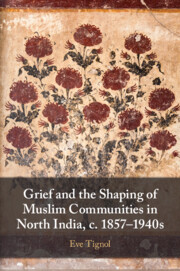Book contents
- Grief and the Shaping of Muslim Communities in north India, c. 1857–1940s
- Grief and the Shaping of Muslim Communities in north India, c. 1857–1940s
- Copyright page
- Contents
- Figures
- Acknowledgements
- Note on Transliteration
- Abbreviations
- Introduction
- 1 A Garden Lost
- 2 Useful Grief
- 3 Memorials, Feelings, and Public Recognition, c. 1911–1915
- 4 Empowering Grief
- 5 Nostalgia in Delhi
- Epilogue
- Glossary
- Bibliography
- Index
3 - Memorials, Feelings, and Public Recognition, c. 1911–1915
Published online by Cambridge University Press: 03 March 2023
- Grief and the Shaping of Muslim Communities in north India, c. 1857–1940s
- Grief and the Shaping of Muslim Communities in north India, c. 1857–1940s
- Copyright page
- Contents
- Figures
- Acknowledgements
- Note on Transliteration
- Abbreviations
- Introduction
- 1 A Garden Lost
- 2 Useful Grief
- 3 Memorials, Feelings, and Public Recognition, c. 1911–1915
- 4 Empowering Grief
- 5 Nostalgia in Delhi
- Epilogue
- Glossary
- Bibliography
- Index
Summary
This chapter considers the emotional registers of Mohamed Ali Jauhar’s periodicals The Comrade (f. 1911) and Hamdard (f. 1913) around Delhi’s urban pasts during the first few years of the construction of New Delhi. The two papers successfully mobilised Delhi’s Muslim population on the issue of urban demolition works. The emotional expression of grief took an anti-colonial turn with the Kanpur mosque incident in 1913 when authorities denied the sincerity of Muslims’ feelings. Grief was no longer turned inwards as in previous reformist movements but decried as the result of colonial oppression. Much of the agitation thereafter aimed at displaying grief to pressurise the colonial state. It claimed the right to patriotic feelings, cultivating an emotional identification between memorials of past Muslim power and a pan-Indian Muslim identity in the making.
- Type
- Chapter
- Information
- Publisher: Cambridge University PressPrint publication year: 2023

